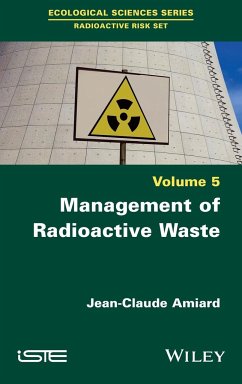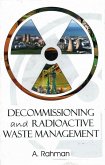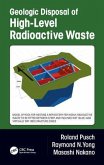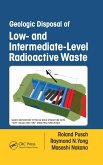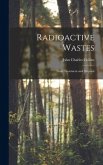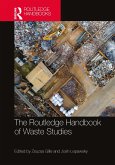Jean-Claude Amiard
Management of Radioactive Waste
Jean-Claude Amiard
Management of Radioactive Waste
- Gebundenes Buch
- Merkliste
- Auf die Merkliste
- Bewerten Bewerten
- Teilen
- Produkt teilen
- Produkterinnerung
- Produkterinnerung
The classification of radioactive waste varies from state to state. This results in different management procedures for each country, while following IAEA and OECD/NEA recommendations. Radioactive waste comes from numerous sources. The largest volumes are generated by the decommissioning and dismantling of nuclear facilities. Long-lived, medium- and high-activity waste - categorized as the most hazardous types of waste - are in fact largely produced by nuclear power reactors, spent fuel reprocessing plants and nuclear accidents. Final disposal of very low-activity, low-activity and very…mehr
Andere Kunden interessierten sich auch für
![Decommissioning and Radioactive Waste Management Decommissioning and Radioactive Waste Management]() A. RahmanDecommissioning and Radioactive Waste Management101,99 €
A. RahmanDecommissioning and Radioactive Waste Management101,99 €![Geologic Disposal of High-Level Radioactive Waste Geologic Disposal of High-Level Radioactive Waste]() Roland PuschGeologic Disposal of High-Level Radioactive Waste233,99 €
Roland PuschGeologic Disposal of High-Level Radioactive Waste233,99 €![Geologic Disposal of Low- And Intermediate-Level Radioactive Waste Geologic Disposal of Low- And Intermediate-Level Radioactive Waste]() Roland PuschGeologic Disposal of Low- And Intermediate-Level Radioactive Waste253,99 €
Roland PuschGeologic Disposal of Low- And Intermediate-Level Radioactive Waste253,99 €![Decision-making and Radioactive Waste Disposal Decision-making and Radioactive Waste Disposal]() Andrew NewmanDecision-making and Radioactive Waste Disposal222,99 €
Andrew NewmanDecision-making and Radioactive Waste Disposal222,99 €![Radioactive Wastes: Their Treatment and Disposal Radioactive Wastes: Their Treatment and Disposal]() John Charles CollinsRadioactive Wastes: Their Treatment and Disposal36,99 €
John Charles CollinsRadioactive Wastes: Their Treatment and Disposal36,99 €![The Routledge Handbook of Waste Studies The Routledge Handbook of Waste Studies]() The Routledge Handbook of Waste Studies296,99 €
The Routledge Handbook of Waste Studies296,99 €![E-Waste Management E-Waste Management]() E-Waste Management212,99 €
E-Waste Management212,99 €-
-
-
The classification of radioactive waste varies from state to state. This results in different management procedures for each country, while following IAEA and OECD/NEA recommendations. Radioactive waste comes from numerous sources. The largest volumes are generated by the decommissioning and dismantling of nuclear facilities. Long-lived, medium- and high-activity waste - categorized as the most hazardous types of waste - are in fact largely produced by nuclear power reactors, spent fuel reprocessing plants and nuclear accidents. Final disposal of very low-activity, low-activity and very short-lived waste is well controlled. However, final solutions for certain categories, including long-lived waste, sorted waste and spent graphite waste, are not yet in place. Management of Radioactive Waste reviews all the possible solutions and presents those chosen by the various states, including a chapter detailing policy on radioactive waste management, taking France as an example.
Produktdetails
- Produktdetails
- Verlag: Wiley
- Seitenzahl: 272
- Erscheinungstermin: 26. Oktober 2021
- Englisch
- Abmessung: 240mm x 161mm x 19mm
- Gewicht: 575g
- ISBN-13: 9781786307224
- ISBN-10: 1786307227
- Artikelnr.: 62562660
- Verlag: Wiley
- Seitenzahl: 272
- Erscheinungstermin: 26. Oktober 2021
- Englisch
- Abmessung: 240mm x 161mm x 19mm
- Gewicht: 575g
- ISBN-13: 9781786307224
- ISBN-10: 1786307227
- Artikelnr.: 62562660
Jean-Claude Amiard is a Doctor of Radioecology, Emeritus Research Director at the CNRS (University of Nantes, France) and former Associate Professor in Quebec and China. He is the author of more than 250 publications, 80 books or book chapters and 150 presentations at international conferences.
Preface xi Acknowledgments xiii Chapter 1. Classifications and Origins of
Radioactive Waste 1 1.1. Introduction 1 1.2. What is radioactive waste? 2
1.3. Classifications of nuclear waste 3 1.3.1. General information on the
classification of radioactive waste 3 1.3.2. The IAEA's recommendations 4
1.3.3. The French classification of radioactive waste 5 1.3.4. American
classification 8 1.3.5. British classification 8 1.3.6. Russian
classification 9 1.3.7. Comparisons of the various classifications 9 1.3.8.
Classification of sealed sources 11 1.4. Origins of nuclear waste 11 1.4.1.
The main radionuclides in radioactive waste 12 1.4.2. Wastes related to the
nuclear fuel cycle 12 1.4.3. Nuclear waste from electricity production 14
1.4.4. Nuclear waste related to military activities 14 1.4.5. Wastes
related to medical and industrial uses 15 1.4.6. Nuclear waste related to
the dismantling of nuclear installations 16 1.4.7. Waste from nuclear
accidents 17 1.5. The global radioactive waste balance 17 1.6. Conclusions
21 Chapter 2. Nuclear Waste Disposal Methods 23 2.1. Introduction. How do
we get rid of nuclear waste? What solutions are there for nuclear waste in
the future? 23 2.2. Nuclear waste management 24 2.2.1. Dilutions 24 2.2.2.
Decontamination 26 2.2.3. Reduction of the volume of radioactive waste 27
2.2.4. Radioactive waste immobilizations 29 2.2.5. The separation of
radionuclides 33 2.2.6. Packaging of radioactive waste packages 34 2.2.7.
Physical decay 35 2.2.8. Final storage 37 2.2.9. Transport of nuclear
materials and radioactive waste 38 2.3. The special case of long-lived
radioactive waste management 39 2.3.1. Treatment and packaging 39 2.3.2.
Temporary storage facilities 42 2.3.3. Long-term storage 46 2.3.4. Storage
in the seabed 48 2.3.5. Geological storage in a deep continental repository
53 2.3.6. Sending into space 59 2.3.7. Immobilization in polar ice 60
2.3.8. Transmutation 61 2.4. Conclusions 65 Chapter 3. Management of
Historic Radioactive Waste and Low-level Waste Around the World 67 3.1.
Introduction 67 3.2. Management of historical radioactive waste 68 3.2.1.
Uranium extraction and concentration waste 68 3.2.2. Direct discharges of
liquid wastes into waterways and reservoirs 70 3.2.3. Historical military
waste 72 3.2.4. The ancient uses of radium 73 3.2.5. Submergence in the
ocean floor 73 3.3. International recommendations of the IAEA and NEA 78
3.3.1. General recommendations 79 3.3.2. Recommendations concerning
graphite waste 83 3.3.3. Radioactive waste management solutions 83 3.3.4.
Waiting and processing time for nuclear fuel 85 3.3.5. The need for
teaching 85 3.4. Some examples of radioactive waste management 86 3.4.1.
International inventories of radioactive waste 86 3.4.2. Surface storage 86
3.4.3. Geological disposal of radioactive waste 89 3.5. Radioactive waste
outside the nuclear fuel cycle 93 3.5.1. Hospital and healthcare waste 93
3.5.2. Industrial and research waste 94 3.6. Conclusions 94 Chapter 4.
Management of Intermediate- and High-level Nuclear Waste 97 4.1.
Introduction 97 4.2. International recommendations of the IAEA and NEA 99
4.2.1. Spent fuel management 99 4.2.2. Management of radioactive waste
resulting from a nuclear accident 100 4.2.3. Final repositories in deep
geological layers 101 4.2.4. Site selection criteria 103 4.2.5. Temporal
evolution of a deep geological repository 104 4.2.6. Underground laboratory
104 4.2.7. Retrievability and recovery 108 4.2.8. Safety file 109 4.2.9.
Decision-making 112 4.2.10. Long-term evolution and post-closure monitoring
113 4.3. High-level radioactive waste management and the public 114 4.3.1.
Public perception of the geological repository project 114 4.3.2. Public
information or communication about the geological repository project 115
4.3.3. Measures to support a radioactive waste management project 116
4.3.4. Public participation in the geological repository project 117 4.3.5.
Information for future generations 118 4.4. Alternative solutions 120
4.4.1. Underwater temporary storage 120 4.4.2. An interim solution: dry
storage 120 4.4.3. A waiting stage: long-term storage 120 4.4.4. The
American perspective of deep drilling 121 4.5. Management of high-level
radioactive waste by the various States 121 4.5.1. States advocating a
closed nuclear fuel cycle 123 4.5.2. States that have reprocessed spent
fuel in the past 127 4.5.3. States with an open nuclear fuel cycle 136 4.6.
Conclusions 143 Chapter 5. Nuclear Waste Management in France 145 5.1.
Introduction 145 5.2. Direct discharges into the environment 147 5.2.1. The
nuclear study centers 147 5.2.2. Nuclear reactors 148 5.2.3. Fuel cycle
plants 148 5.3. The inventory of nuclear waste in France 149 5.3.1.
Military waste 149 5.3.2. Civilian waste 152 5.4. Nuclear waste management
in France 157 5.4.1. The regulatory context 157 5.4.2. The National
Radioactive Materials and Waste Management Plan (PNGMDR) 158 5.4.3. The
different actors in nuclear waste management in France 159 5.5. The
organization of storage for identified waste 164 5.5.1. The various types
of containers 164 5.5.2. The management of very short-lived radioactive
waste 166 5.5.3. Management of very low-level radioactive waste 166 5.5.4.
Disposal centers for low- and intermediate-level short-lived nuclear waste
in France 167 5.5.5. Management of low-level, long-lived nuclear waste in
France 168 5.5.6. Management of long-lived intermediate- and high-level
waste in France 170 5.5.7. Fierce opposition and the arrival of social
problems 184 5.5.8. A centralized pool as an interim option 185 5.5.9.
Radioactive waste from the reprocessing of foreign spent fuel 186 5.6. The
management of specific waste and waste without a channel 188 5.6.1.
Management of historical waste 189 5.6.2. Storage of tritiated waste 190
5.6.3. Waste of natural origin 191 5.6.4. Submerged waste 194 5.7. French
challenges to the radioactive waste management policy 195 5.8. Conclusions
197 5.8.1. Shortcomings in several categories of radioactive waste 197
5.8.2. Recent developments in French nuclear policy 197 5.8.3. Policy
change on the closed cycle? 198 5.8.4. Redefinition of radioactive waste
and radioactive material 198 5.8.5. The cost of waste management 199
Chapter 6. General Conclusions 201 6.1. Introduction 201 6.2. The main
problems concerning radioactive waste 201 6.2.1. The problem of multiple
classifications 201 6.2.2. Radioactive waste or nuclear material? 202
6.2.3. Waste without a channel 202 6.2.4. Long-lived waste 202 6.2.5. Very
low-level waste 202 6.3. Innovations in radioactive waste management 203
6.3.1. Research on separation and transmutation 203 6.3.2. Research on the
aging of packaging 204 6.3.3. Research on recycled nuclear fuel and
cladding 206 6.3.4. Research on deep burial 207 6.3.5. Communication to the
public 211 List of Acronyms 213 References 219 Index 251
Radioactive Waste 1 1.1. Introduction 1 1.2. What is radioactive waste? 2
1.3. Classifications of nuclear waste 3 1.3.1. General information on the
classification of radioactive waste 3 1.3.2. The IAEA's recommendations 4
1.3.3. The French classification of radioactive waste 5 1.3.4. American
classification 8 1.3.5. British classification 8 1.3.6. Russian
classification 9 1.3.7. Comparisons of the various classifications 9 1.3.8.
Classification of sealed sources 11 1.4. Origins of nuclear waste 11 1.4.1.
The main radionuclides in radioactive waste 12 1.4.2. Wastes related to the
nuclear fuel cycle 12 1.4.3. Nuclear waste from electricity production 14
1.4.4. Nuclear waste related to military activities 14 1.4.5. Wastes
related to medical and industrial uses 15 1.4.6. Nuclear waste related to
the dismantling of nuclear installations 16 1.4.7. Waste from nuclear
accidents 17 1.5. The global radioactive waste balance 17 1.6. Conclusions
21 Chapter 2. Nuclear Waste Disposal Methods 23 2.1. Introduction. How do
we get rid of nuclear waste? What solutions are there for nuclear waste in
the future? 23 2.2. Nuclear waste management 24 2.2.1. Dilutions 24 2.2.2.
Decontamination 26 2.2.3. Reduction of the volume of radioactive waste 27
2.2.4. Radioactive waste immobilizations 29 2.2.5. The separation of
radionuclides 33 2.2.6. Packaging of radioactive waste packages 34 2.2.7.
Physical decay 35 2.2.8. Final storage 37 2.2.9. Transport of nuclear
materials and radioactive waste 38 2.3. The special case of long-lived
radioactive waste management 39 2.3.1. Treatment and packaging 39 2.3.2.
Temporary storage facilities 42 2.3.3. Long-term storage 46 2.3.4. Storage
in the seabed 48 2.3.5. Geological storage in a deep continental repository
53 2.3.6. Sending into space 59 2.3.7. Immobilization in polar ice 60
2.3.8. Transmutation 61 2.4. Conclusions 65 Chapter 3. Management of
Historic Radioactive Waste and Low-level Waste Around the World 67 3.1.
Introduction 67 3.2. Management of historical radioactive waste 68 3.2.1.
Uranium extraction and concentration waste 68 3.2.2. Direct discharges of
liquid wastes into waterways and reservoirs 70 3.2.3. Historical military
waste 72 3.2.4. The ancient uses of radium 73 3.2.5. Submergence in the
ocean floor 73 3.3. International recommendations of the IAEA and NEA 78
3.3.1. General recommendations 79 3.3.2. Recommendations concerning
graphite waste 83 3.3.3. Radioactive waste management solutions 83 3.3.4.
Waiting and processing time for nuclear fuel 85 3.3.5. The need for
teaching 85 3.4. Some examples of radioactive waste management 86 3.4.1.
International inventories of radioactive waste 86 3.4.2. Surface storage 86
3.4.3. Geological disposal of radioactive waste 89 3.5. Radioactive waste
outside the nuclear fuel cycle 93 3.5.1. Hospital and healthcare waste 93
3.5.2. Industrial and research waste 94 3.6. Conclusions 94 Chapter 4.
Management of Intermediate- and High-level Nuclear Waste 97 4.1.
Introduction 97 4.2. International recommendations of the IAEA and NEA 99
4.2.1. Spent fuel management 99 4.2.2. Management of radioactive waste
resulting from a nuclear accident 100 4.2.3. Final repositories in deep
geological layers 101 4.2.4. Site selection criteria 103 4.2.5. Temporal
evolution of a deep geological repository 104 4.2.6. Underground laboratory
104 4.2.7. Retrievability and recovery 108 4.2.8. Safety file 109 4.2.9.
Decision-making 112 4.2.10. Long-term evolution and post-closure monitoring
113 4.3. High-level radioactive waste management and the public 114 4.3.1.
Public perception of the geological repository project 114 4.3.2. Public
information or communication about the geological repository project 115
4.3.3. Measures to support a radioactive waste management project 116
4.3.4. Public participation in the geological repository project 117 4.3.5.
Information for future generations 118 4.4. Alternative solutions 120
4.4.1. Underwater temporary storage 120 4.4.2. An interim solution: dry
storage 120 4.4.3. A waiting stage: long-term storage 120 4.4.4. The
American perspective of deep drilling 121 4.5. Management of high-level
radioactive waste by the various States 121 4.5.1. States advocating a
closed nuclear fuel cycle 123 4.5.2. States that have reprocessed spent
fuel in the past 127 4.5.3. States with an open nuclear fuel cycle 136 4.6.
Conclusions 143 Chapter 5. Nuclear Waste Management in France 145 5.1.
Introduction 145 5.2. Direct discharges into the environment 147 5.2.1. The
nuclear study centers 147 5.2.2. Nuclear reactors 148 5.2.3. Fuel cycle
plants 148 5.3. The inventory of nuclear waste in France 149 5.3.1.
Military waste 149 5.3.2. Civilian waste 152 5.4. Nuclear waste management
in France 157 5.4.1. The regulatory context 157 5.4.2. The National
Radioactive Materials and Waste Management Plan (PNGMDR) 158 5.4.3. The
different actors in nuclear waste management in France 159 5.5. The
organization of storage for identified waste 164 5.5.1. The various types
of containers 164 5.5.2. The management of very short-lived radioactive
waste 166 5.5.3. Management of very low-level radioactive waste 166 5.5.4.
Disposal centers for low- and intermediate-level short-lived nuclear waste
in France 167 5.5.5. Management of low-level, long-lived nuclear waste in
France 168 5.5.6. Management of long-lived intermediate- and high-level
waste in France 170 5.5.7. Fierce opposition and the arrival of social
problems 184 5.5.8. A centralized pool as an interim option 185 5.5.9.
Radioactive waste from the reprocessing of foreign spent fuel 186 5.6. The
management of specific waste and waste without a channel 188 5.6.1.
Management of historical waste 189 5.6.2. Storage of tritiated waste 190
5.6.3. Waste of natural origin 191 5.6.4. Submerged waste 194 5.7. French
challenges to the radioactive waste management policy 195 5.8. Conclusions
197 5.8.1. Shortcomings in several categories of radioactive waste 197
5.8.2. Recent developments in French nuclear policy 197 5.8.3. Policy
change on the closed cycle? 198 5.8.4. Redefinition of radioactive waste
and radioactive material 198 5.8.5. The cost of waste management 199
Chapter 6. General Conclusions 201 6.1. Introduction 201 6.2. The main
problems concerning radioactive waste 201 6.2.1. The problem of multiple
classifications 201 6.2.2. Radioactive waste or nuclear material? 202
6.2.3. Waste without a channel 202 6.2.4. Long-lived waste 202 6.2.5. Very
low-level waste 202 6.3. Innovations in radioactive waste management 203
6.3.1. Research on separation and transmutation 203 6.3.2. Research on the
aging of packaging 204 6.3.3. Research on recycled nuclear fuel and
cladding 206 6.3.4. Research on deep burial 207 6.3.5. Communication to the
public 211 List of Acronyms 213 References 219 Index 251
Preface xi Acknowledgments xiii Chapter 1. Classifications and Origins of
Radioactive Waste 1 1.1. Introduction 1 1.2. What is radioactive waste? 2
1.3. Classifications of nuclear waste 3 1.3.1. General information on the
classification of radioactive waste 3 1.3.2. The IAEA's recommendations 4
1.3.3. The French classification of radioactive waste 5 1.3.4. American
classification 8 1.3.5. British classification 8 1.3.6. Russian
classification 9 1.3.7. Comparisons of the various classifications 9 1.3.8.
Classification of sealed sources 11 1.4. Origins of nuclear waste 11 1.4.1.
The main radionuclides in radioactive waste 12 1.4.2. Wastes related to the
nuclear fuel cycle 12 1.4.3. Nuclear waste from electricity production 14
1.4.4. Nuclear waste related to military activities 14 1.4.5. Wastes
related to medical and industrial uses 15 1.4.6. Nuclear waste related to
the dismantling of nuclear installations 16 1.4.7. Waste from nuclear
accidents 17 1.5. The global radioactive waste balance 17 1.6. Conclusions
21 Chapter 2. Nuclear Waste Disposal Methods 23 2.1. Introduction. How do
we get rid of nuclear waste? What solutions are there for nuclear waste in
the future? 23 2.2. Nuclear waste management 24 2.2.1. Dilutions 24 2.2.2.
Decontamination 26 2.2.3. Reduction of the volume of radioactive waste 27
2.2.4. Radioactive waste immobilizations 29 2.2.5. The separation of
radionuclides 33 2.2.6. Packaging of radioactive waste packages 34 2.2.7.
Physical decay 35 2.2.8. Final storage 37 2.2.9. Transport of nuclear
materials and radioactive waste 38 2.3. The special case of long-lived
radioactive waste management 39 2.3.1. Treatment and packaging 39 2.3.2.
Temporary storage facilities 42 2.3.3. Long-term storage 46 2.3.4. Storage
in the seabed 48 2.3.5. Geological storage in a deep continental repository
53 2.3.6. Sending into space 59 2.3.7. Immobilization in polar ice 60
2.3.8. Transmutation 61 2.4. Conclusions 65 Chapter 3. Management of
Historic Radioactive Waste and Low-level Waste Around the World 67 3.1.
Introduction 67 3.2. Management of historical radioactive waste 68 3.2.1.
Uranium extraction and concentration waste 68 3.2.2. Direct discharges of
liquid wastes into waterways and reservoirs 70 3.2.3. Historical military
waste 72 3.2.4. The ancient uses of radium 73 3.2.5. Submergence in the
ocean floor 73 3.3. International recommendations of the IAEA and NEA 78
3.3.1. General recommendations 79 3.3.2. Recommendations concerning
graphite waste 83 3.3.3. Radioactive waste management solutions 83 3.3.4.
Waiting and processing time for nuclear fuel 85 3.3.5. The need for
teaching 85 3.4. Some examples of radioactive waste management 86 3.4.1.
International inventories of radioactive waste 86 3.4.2. Surface storage 86
3.4.3. Geological disposal of radioactive waste 89 3.5. Radioactive waste
outside the nuclear fuel cycle 93 3.5.1. Hospital and healthcare waste 93
3.5.2. Industrial and research waste 94 3.6. Conclusions 94 Chapter 4.
Management of Intermediate- and High-level Nuclear Waste 97 4.1.
Introduction 97 4.2. International recommendations of the IAEA and NEA 99
4.2.1. Spent fuel management 99 4.2.2. Management of radioactive waste
resulting from a nuclear accident 100 4.2.3. Final repositories in deep
geological layers 101 4.2.4. Site selection criteria 103 4.2.5. Temporal
evolution of a deep geological repository 104 4.2.6. Underground laboratory
104 4.2.7. Retrievability and recovery 108 4.2.8. Safety file 109 4.2.9.
Decision-making 112 4.2.10. Long-term evolution and post-closure monitoring
113 4.3. High-level radioactive waste management and the public 114 4.3.1.
Public perception of the geological repository project 114 4.3.2. Public
information or communication about the geological repository project 115
4.3.3. Measures to support a radioactive waste management project 116
4.3.4. Public participation in the geological repository project 117 4.3.5.
Information for future generations 118 4.4. Alternative solutions 120
4.4.1. Underwater temporary storage 120 4.4.2. An interim solution: dry
storage 120 4.4.3. A waiting stage: long-term storage 120 4.4.4. The
American perspective of deep drilling 121 4.5. Management of high-level
radioactive waste by the various States 121 4.5.1. States advocating a
closed nuclear fuel cycle 123 4.5.2. States that have reprocessed spent
fuel in the past 127 4.5.3. States with an open nuclear fuel cycle 136 4.6.
Conclusions 143 Chapter 5. Nuclear Waste Management in France 145 5.1.
Introduction 145 5.2. Direct discharges into the environment 147 5.2.1. The
nuclear study centers 147 5.2.2. Nuclear reactors 148 5.2.3. Fuel cycle
plants 148 5.3. The inventory of nuclear waste in France 149 5.3.1.
Military waste 149 5.3.2. Civilian waste 152 5.4. Nuclear waste management
in France 157 5.4.1. The regulatory context 157 5.4.2. The National
Radioactive Materials and Waste Management Plan (PNGMDR) 158 5.4.3. The
different actors in nuclear waste management in France 159 5.5. The
organization of storage for identified waste 164 5.5.1. The various types
of containers 164 5.5.2. The management of very short-lived radioactive
waste 166 5.5.3. Management of very low-level radioactive waste 166 5.5.4.
Disposal centers for low- and intermediate-level short-lived nuclear waste
in France 167 5.5.5. Management of low-level, long-lived nuclear waste in
France 168 5.5.6. Management of long-lived intermediate- and high-level
waste in France 170 5.5.7. Fierce opposition and the arrival of social
problems 184 5.5.8. A centralized pool as an interim option 185 5.5.9.
Radioactive waste from the reprocessing of foreign spent fuel 186 5.6. The
management of specific waste and waste without a channel 188 5.6.1.
Management of historical waste 189 5.6.2. Storage of tritiated waste 190
5.6.3. Waste of natural origin 191 5.6.4. Submerged waste 194 5.7. French
challenges to the radioactive waste management policy 195 5.8. Conclusions
197 5.8.1. Shortcomings in several categories of radioactive waste 197
5.8.2. Recent developments in French nuclear policy 197 5.8.3. Policy
change on the closed cycle? 198 5.8.4. Redefinition of radioactive waste
and radioactive material 198 5.8.5. The cost of waste management 199
Chapter 6. General Conclusions 201 6.1. Introduction 201 6.2. The main
problems concerning radioactive waste 201 6.2.1. The problem of multiple
classifications 201 6.2.2. Radioactive waste or nuclear material? 202
6.2.3. Waste without a channel 202 6.2.4. Long-lived waste 202 6.2.5. Very
low-level waste 202 6.3. Innovations in radioactive waste management 203
6.3.1. Research on separation and transmutation 203 6.3.2. Research on the
aging of packaging 204 6.3.3. Research on recycled nuclear fuel and
cladding 206 6.3.4. Research on deep burial 207 6.3.5. Communication to the
public 211 List of Acronyms 213 References 219 Index 251
Radioactive Waste 1 1.1. Introduction 1 1.2. What is radioactive waste? 2
1.3. Classifications of nuclear waste 3 1.3.1. General information on the
classification of radioactive waste 3 1.3.2. The IAEA's recommendations 4
1.3.3. The French classification of radioactive waste 5 1.3.4. American
classification 8 1.3.5. British classification 8 1.3.6. Russian
classification 9 1.3.7. Comparisons of the various classifications 9 1.3.8.
Classification of sealed sources 11 1.4. Origins of nuclear waste 11 1.4.1.
The main radionuclides in radioactive waste 12 1.4.2. Wastes related to the
nuclear fuel cycle 12 1.4.3. Nuclear waste from electricity production 14
1.4.4. Nuclear waste related to military activities 14 1.4.5. Wastes
related to medical and industrial uses 15 1.4.6. Nuclear waste related to
the dismantling of nuclear installations 16 1.4.7. Waste from nuclear
accidents 17 1.5. The global radioactive waste balance 17 1.6. Conclusions
21 Chapter 2. Nuclear Waste Disposal Methods 23 2.1. Introduction. How do
we get rid of nuclear waste? What solutions are there for nuclear waste in
the future? 23 2.2. Nuclear waste management 24 2.2.1. Dilutions 24 2.2.2.
Decontamination 26 2.2.3. Reduction of the volume of radioactive waste 27
2.2.4. Radioactive waste immobilizations 29 2.2.5. The separation of
radionuclides 33 2.2.6. Packaging of radioactive waste packages 34 2.2.7.
Physical decay 35 2.2.8. Final storage 37 2.2.9. Transport of nuclear
materials and radioactive waste 38 2.3. The special case of long-lived
radioactive waste management 39 2.3.1. Treatment and packaging 39 2.3.2.
Temporary storage facilities 42 2.3.3. Long-term storage 46 2.3.4. Storage
in the seabed 48 2.3.5. Geological storage in a deep continental repository
53 2.3.6. Sending into space 59 2.3.7. Immobilization in polar ice 60
2.3.8. Transmutation 61 2.4. Conclusions 65 Chapter 3. Management of
Historic Radioactive Waste and Low-level Waste Around the World 67 3.1.
Introduction 67 3.2. Management of historical radioactive waste 68 3.2.1.
Uranium extraction and concentration waste 68 3.2.2. Direct discharges of
liquid wastes into waterways and reservoirs 70 3.2.3. Historical military
waste 72 3.2.4. The ancient uses of radium 73 3.2.5. Submergence in the
ocean floor 73 3.3. International recommendations of the IAEA and NEA 78
3.3.1. General recommendations 79 3.3.2. Recommendations concerning
graphite waste 83 3.3.3. Radioactive waste management solutions 83 3.3.4.
Waiting and processing time for nuclear fuel 85 3.3.5. The need for
teaching 85 3.4. Some examples of radioactive waste management 86 3.4.1.
International inventories of radioactive waste 86 3.4.2. Surface storage 86
3.4.3. Geological disposal of radioactive waste 89 3.5. Radioactive waste
outside the nuclear fuel cycle 93 3.5.1. Hospital and healthcare waste 93
3.5.2. Industrial and research waste 94 3.6. Conclusions 94 Chapter 4.
Management of Intermediate- and High-level Nuclear Waste 97 4.1.
Introduction 97 4.2. International recommendations of the IAEA and NEA 99
4.2.1. Spent fuel management 99 4.2.2. Management of radioactive waste
resulting from a nuclear accident 100 4.2.3. Final repositories in deep
geological layers 101 4.2.4. Site selection criteria 103 4.2.5. Temporal
evolution of a deep geological repository 104 4.2.6. Underground laboratory
104 4.2.7. Retrievability and recovery 108 4.2.8. Safety file 109 4.2.9.
Decision-making 112 4.2.10. Long-term evolution and post-closure monitoring
113 4.3. High-level radioactive waste management and the public 114 4.3.1.
Public perception of the geological repository project 114 4.3.2. Public
information or communication about the geological repository project 115
4.3.3. Measures to support a radioactive waste management project 116
4.3.4. Public participation in the geological repository project 117 4.3.5.
Information for future generations 118 4.4. Alternative solutions 120
4.4.1. Underwater temporary storage 120 4.4.2. An interim solution: dry
storage 120 4.4.3. A waiting stage: long-term storage 120 4.4.4. The
American perspective of deep drilling 121 4.5. Management of high-level
radioactive waste by the various States 121 4.5.1. States advocating a
closed nuclear fuel cycle 123 4.5.2. States that have reprocessed spent
fuel in the past 127 4.5.3. States with an open nuclear fuel cycle 136 4.6.
Conclusions 143 Chapter 5. Nuclear Waste Management in France 145 5.1.
Introduction 145 5.2. Direct discharges into the environment 147 5.2.1. The
nuclear study centers 147 5.2.2. Nuclear reactors 148 5.2.3. Fuel cycle
plants 148 5.3. The inventory of nuclear waste in France 149 5.3.1.
Military waste 149 5.3.2. Civilian waste 152 5.4. Nuclear waste management
in France 157 5.4.1. The regulatory context 157 5.4.2. The National
Radioactive Materials and Waste Management Plan (PNGMDR) 158 5.4.3. The
different actors in nuclear waste management in France 159 5.5. The
organization of storage for identified waste 164 5.5.1. The various types
of containers 164 5.5.2. The management of very short-lived radioactive
waste 166 5.5.3. Management of very low-level radioactive waste 166 5.5.4.
Disposal centers for low- and intermediate-level short-lived nuclear waste
in France 167 5.5.5. Management of low-level, long-lived nuclear waste in
France 168 5.5.6. Management of long-lived intermediate- and high-level
waste in France 170 5.5.7. Fierce opposition and the arrival of social
problems 184 5.5.8. A centralized pool as an interim option 185 5.5.9.
Radioactive waste from the reprocessing of foreign spent fuel 186 5.6. The
management of specific waste and waste without a channel 188 5.6.1.
Management of historical waste 189 5.6.2. Storage of tritiated waste 190
5.6.3. Waste of natural origin 191 5.6.4. Submerged waste 194 5.7. French
challenges to the radioactive waste management policy 195 5.8. Conclusions
197 5.8.1. Shortcomings in several categories of radioactive waste 197
5.8.2. Recent developments in French nuclear policy 197 5.8.3. Policy
change on the closed cycle? 198 5.8.4. Redefinition of radioactive waste
and radioactive material 198 5.8.5. The cost of waste management 199
Chapter 6. General Conclusions 201 6.1. Introduction 201 6.2. The main
problems concerning radioactive waste 201 6.2.1. The problem of multiple
classifications 201 6.2.2. Radioactive waste or nuclear material? 202
6.2.3. Waste without a channel 202 6.2.4. Long-lived waste 202 6.2.5. Very
low-level waste 202 6.3. Innovations in radioactive waste management 203
6.3.1. Research on separation and transmutation 203 6.3.2. Research on the
aging of packaging 204 6.3.3. Research on recycled nuclear fuel and
cladding 206 6.3.4. Research on deep burial 207 6.3.5. Communication to the
public 211 List of Acronyms 213 References 219 Index 251

